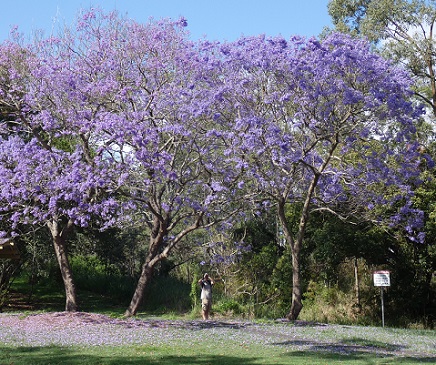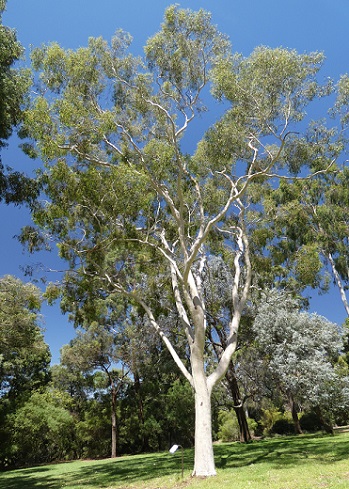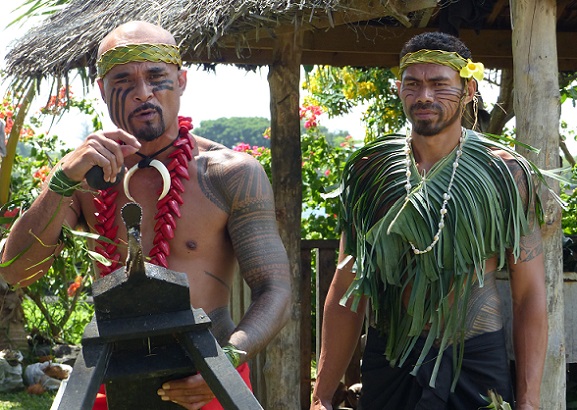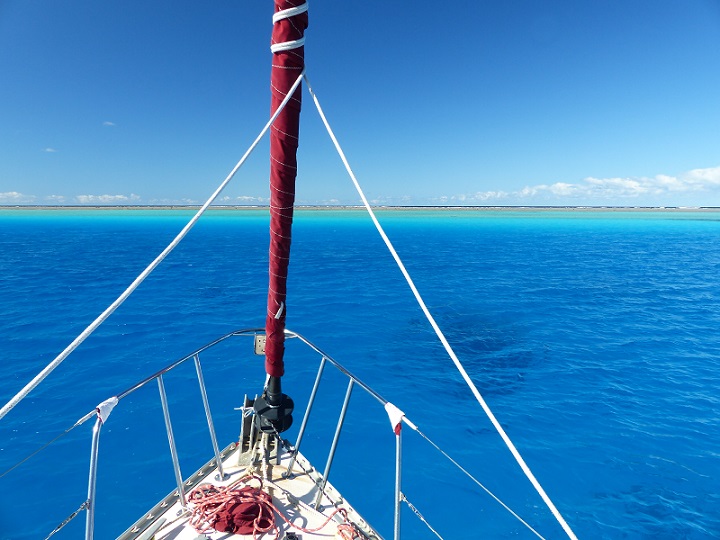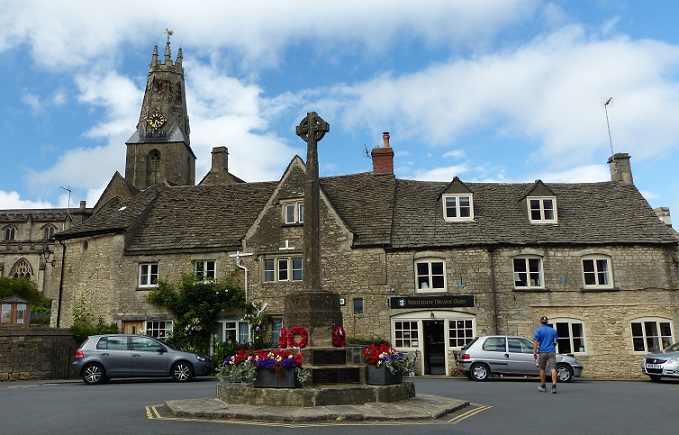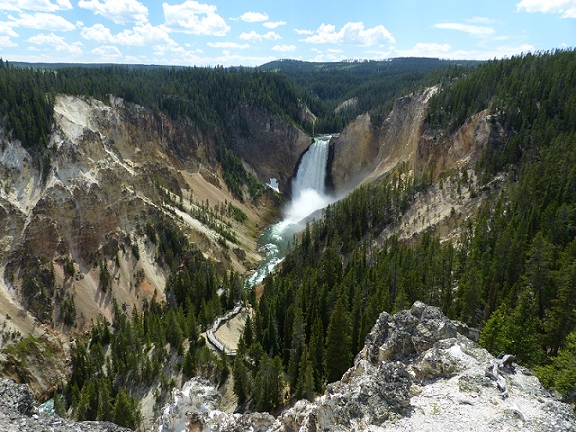
Tregoning
12 April 2024 | We are back aboard Tregoning in Mersin Marina, Mersin, Türkiye
02 April 2024 | We are in Toronto Airport, Canada: Tregoning is in Mersin Marina, Mersin, Türkiye
25 February 2024 | We are back in Gainesville, FL: Tregoning is in Mersin Marina, Mersin, Türkiye
18 February 2024 | We are in Glenwood, New Mexico: Tregoning is in Mersin Marina, Mersin, Türkiye
12 February 2024 | We are in Morro Bay, California: Tregoning is in Mersin Marina, Mersin, Türkiye
19 January 2024 | We are in Vancouver, BC Canada: Tregoning is in Mersin Marina, Mersin, Türkiye
01 January 2024 | We are in Washington State: Tregoning is in Mersin Marina, Mersin, Türkiye
15 December 2023 | We are in Minnesota: Tregoning is in Mersin Marina, Mersin, Türkiye
18 November 2023 | We are in Florida: Tregoning is in Mersin Marina, Mersin, Türkiye
29 October 2023 | We're in Florida - Tregoning is at B-dock, Mersin Marina, Mersin, Türkiye
21 October 2023 | 7 Oda Kapadokya Cave Hotel, Ürgüp, Türkiye
14 October 2023 | Hotel Aşikoğlu, Boğazkale, Türkiye
07 October 2023 | B-dock, Mersin Marina, Mersin, Türkiye
19 September 2023 | “Chez Jon & Angela”, Near Otterton, Devon, UK
14 September 2023 | Airbnb in Fortuneswell on the Isle of Portland, Dorset, UK
11 September 2023 | With Mike, Grange-over-Sands, Cumbria, UK
03 September 2023 | Ardington House, Ardington, Oxfordshire, UK
24 August 2023 | Near "Chez Joan and Peter", College of Roseisle, Moray, Scotland
11 August 2023 | Andrew's house (not exactly), Lichfield, UK
22 July 2023 | Chez Gail, near the New York Café, Budapest, Hungary
ALMOST in the tropics
06 June 2017 | North end of North Minerva Reef, South Pacific Ocean
Photo: The splendid turquoise of topical waters; Tregoning’s bow points to the thin brown line of the coral reef at North Minerva Reef
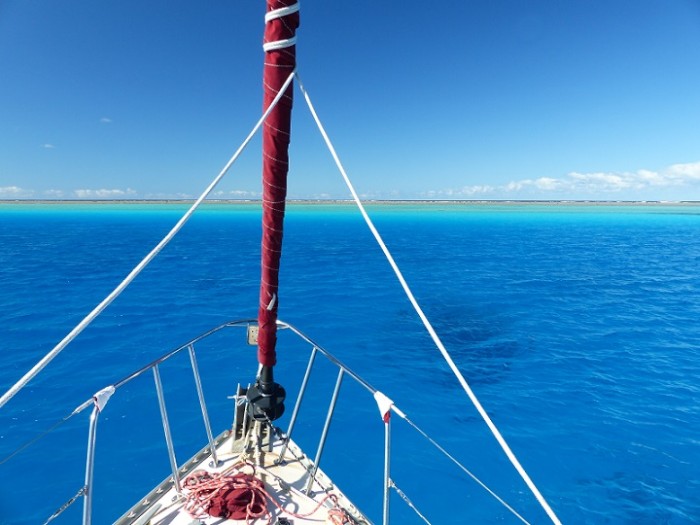
Woohoo! After more than 19 months away, we are finally back, in the tropics...well, almost...North Minerva Reef is just 10 minutes of latitude, or 10 nm, south of the Tropic of Capricorn. And it is GOOD.
After three weeks of waiting, we finally left New Zealand by releasing the dock-lines from Marsden Cove Marina at 11:40 am on Saturday May 27th.
We crossed the 180 degree meridian about 24 hours before arriving at Minerva Reef but the date did not change. In the South Pacific, the International Dateline makes an easterly detour to longitude 172.5 degree west, presumably so that Tonga and the Kermadec Islands are on the same day as New Zealand.
One week and five hours, and 850 nm later, we set the anchor in white sand under crystal-clear water on the north side of the lagoon inside North Minerva Reef.
Conditions:
The first day out was pretty lumpy with 3 m (10 foot) seas and fairly light winds so we had to motor until the wind picked up enough to keep the sails full as the boat rose and fell with the waves. One crew who had never suffered from seasickness before but were new to blue-water sailing, later reported that they had suffered from synchronized vomiting during those initial rough conditions. We considered ourselves lucky not be so stricken, especially after our long hiatus from ocean sailing, but perhaps experience had taught us to limit our below-deck activities during such chaos.
After that, the seas gradually calmed (until the last day when they regrew to 1.5 m or 5 feet) and the wind came and went. The last evening of our passage was punctuated by several brief squalls, one of which suddenly dropped the wind to zero (with much slapping of the limp sails in the waves), but most of which saw the wind peak at 25 knots and sent us scurrying downwind for a few minutes so as not to be too heeled-over or racing too fast in the dark conditions.
We sailed for 108 hours (including a whole day using the asymmetrical spinnaker) and motored for 65 hours. Conditions were suitable for sailing on the final day but we would have arrived at the reef after dark so, reluctantly, we motored on a direct course to ensure arriving in daylight.
At 3 am on our first night out, the water temperature was 67.6 F (19.8 C) and on our last morning before arriving at Minerva it was 76 F (24.4 C) so we are back to wearing shorts and tee-shirts. We get a little chilled after snorkeling for 30 minutes or so but who's complaining?
Other vessels:
About 10 other boats left Marsden Cove the same day, so Customs Office Bruce had a busy morning processing all of our departure paperwork, but it all seemed to go smoothly. We could see the lights of 4 other boats during the first night but after that we were mostly on our own. We listened to the weather forecasts from Gulf Harbour Radio every morning, and at 5 pm we checked-in on the SSB radio with an informal network of the 10 boats that had left Marsden Cove together. Michael on SV Astarté was the net-controller and he did an excellent job of keeping track of us all and providing a good dose of humor.
In the middle of nowhere, we had to divert downwind for half an hour to cross behind the fuel tanker M/T Box (say the name out loud and it is quite cute). We could see a half-dozen boats transmitting on AIS as we passed on the west side of South Minerva Reef and another five were leaving that reef and heading, like us, to North Minerva.
During our first couple of nights at North Minerva Reef, we were accompanied by 20 other anchored sailboats including our friends on SVs Scoots, Free Spirit, Devocean, and Silhouette II. Quite a few of us were fanned out at the north end but others were spread all around the circular, 3 nm diameter lagoon. There is no land associated with this reef and at low tide just a few knobs of old coral or wrecks stick out of the water. Otherwise, the waves breaking on the reef are the only sign that the atoll is there. It is quite strange to be in bouncy seas in the middle of the ocean and approach boats that are sitting very calmly with only a thin line of white waves between us.

Approaching Minerva Reef with a boat anchored in the calm waters of the lagoon beyond the line of waves breaking on the reef
Equipment:
Famous last words, but as far as we can tell, all of our equipment worked well and without damage. The only breakage was a small plastic chain that Randall was testing on the lines that attach to the wheel in the cockpit from Susie (the self-steering wind-vane). Although the plastic was not strong enough, the proof-of-concept test was sufficient that he will replace it with some metal chain. This can be used with fast-release clips so that if we quickly need to release the wheel for hand-steering in squall conditions, it is easier to unclip the chain than trying to untie knots.
During the week, three of the boats caught fishing line or netting in their propellers which is an extraordinarily high frequency for the open ocean. Two crews were able to shake or cut the lines free during lulls in the wind but single-hander Phil on Silhouette, could not get the net off his propeller so had to sail into the pass at North Minerva and anchor before he could don scuba gear and cut the net off. He had been to Minerva several times before but to be sure that he had no problems, three dinghies were waiting for him to provide power if he had any difficulties in the pass. His unassisted entry went very smoothly and it was a large tangle of netting that he finally extracted.
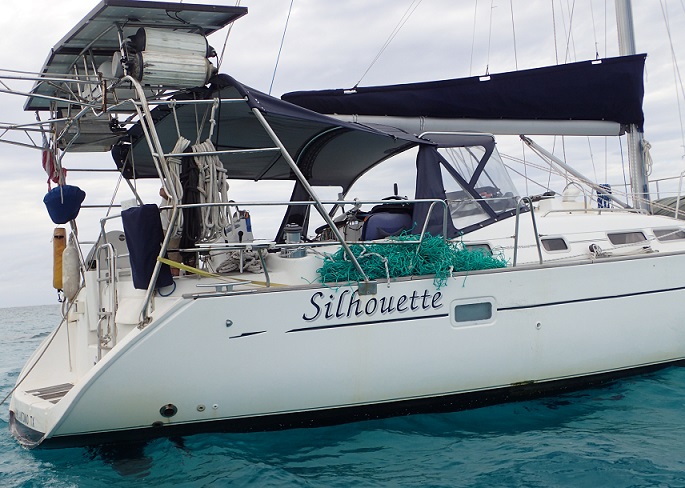
The pile of green netting that Phil had to remove from the propeller of Silhouette
One of our network boats that was heading straight to Fiji, passed several Japanese fishing boats which seemed to have a large amount of discarded netting and line near them. After reporting this to Gulf Habour Radio, this information was passed along to the appropriate fisheries-management agency and we hope that there will be some suitable consequences for such flagrant littering of the ocean.
Wildlife:
In the initial rough conditions, it was difficult to identify the sea birds through the binoculars but I did briefly see an antipodean albatross on the second morning. After that there were a few shearwaters and petrels but not as many seabirds as I had expected. On the fourth day out, a welcome swallow landed on the safely rail and stayed there for about 30 minutes. It was a long way from land and looked as though it might appreciate a ride all the way back to New Zealand. Sadly, we were not headed in the right direction. I did not see which way it went when it took-off but there were not going to be many insects for food for quite a long way in any direction. Several boats reported seeing a swallow and it is likely that it was the same bird trying to find a ride going in the right direction.

The welcome swallow that hitched a ride aboard Tregoning for a while
The only marine mammals we saw were three cetaceans that briefly followed us towards the end of our passage. We did not get a very good look at them, but they were about the size of, and had dorsal fins that looked like those of, bottlenose dolphins although their blow was larger and more visible than I would expect from dolphins.
The history of Minerva Reefs:
Tonga first laid official claim that the Minerva Reefs were part of the Kingdom of Tonga in 1972. This action was precipitated by a Las Vegas property developer who established the Ocean Life Research Foundation with the intent to create a tax-free Republic of Minerva on the reefs. Barges of sand were sent from Australia to raise the surface of the reef sufficiently high to allow the construction of a small tower and flag. After issuing a proclamation to "confirm the rights of the Kingdom of Tonga to these islands", one account alleges that the Tongan king himself sailed to Minerva in order to tear down the flag of the interloping republic.
In 2005, Fiji filed a complaint to the International Seabed Authority, disputing Tonga's claim to the Minerva Reefs as islands and asserting that the reefs occur within Fiji's exclusive economic zone. Around 2011, despite Tonga's sovereignty in the Minerva Reefs being recognized by the South Pacific Forum, Fiji sent a navy warship to the lagoon in retaliation for Tonga granting sanctuary and citizenship to a high-ranking member of the Fijian military who had fled the dictatorship in his homeland after being accused of plotting a coup. The Fijian ship destroyed navigation beacons that the Tongans had erected and ordered cruising boats on their way to New Zealand to leave the reefs immediately. Tonga then sent two naval patrol boats to Minerva and the Fijian ship withdrew. It appears that the issue of sovereignty of the reefs is still in dispute although in 2014, Tonga offered to exchange Minerva for the Lau Group of islands that are currently part of Fiji but have close historical and ancestral connections to Tonga. Fortunately for cruisers, at the moment, the dispute does not seem to be preventing their use of the anchorage and Tongan authorities do not insist that sailors check-in to Tonga before visiting these reefs.
Life at Minerva:
We have been snorkeling inside the lagoon on parts of an old wreck and nearby coral heads. It is staggering how few fish names I can remember but I do at least recognize which ones look familiar and which may be new (one confirmed new sighting for me of a three-band demoiselle so far). Randall is wielding our new underwater camera, so I can concentrate on fish-spotting but when I look at the photos afterwards, it helps me to distinguish between some of the similar species. So far we have only seen one small white-tipped reef shark but I am sure that there will be more.
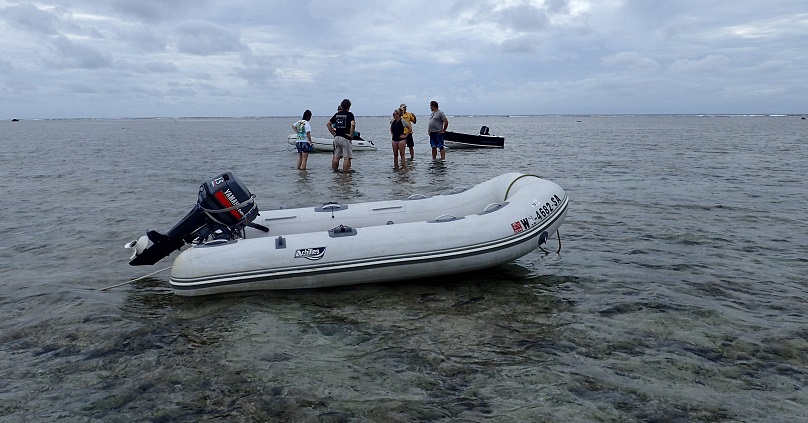
About to go for a stroll in the middle of the South Pacific Ocean
At low tide, it is possible to walk on the reef. It is still under a thin layer of water and we have to be careful to avoid any living coral, but most of the top of the reef is dead coral that could not survive drying at extreme low tides or being pounded by storm-waves. Some people go out on the reef at night to look for lobsters that walk around after dark. We may do this one evening, while the low-tide is still early in the night.
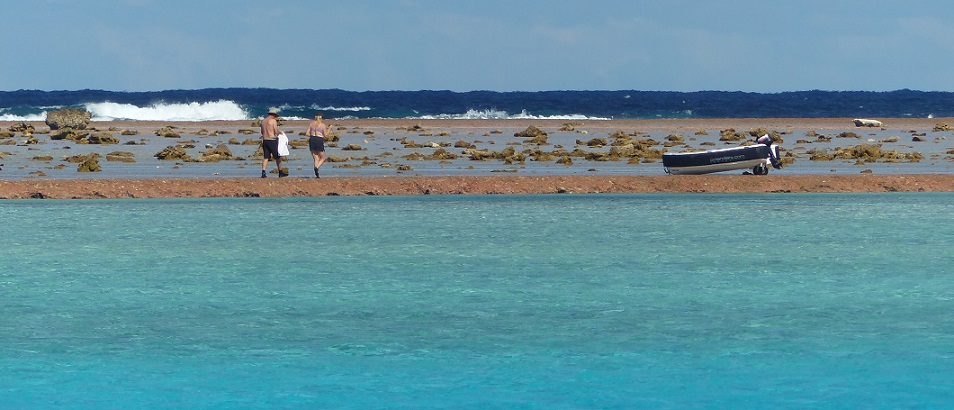
Seen from within the lagoon at North Minerva, Chuck and Lauri walk towards their dinghy on the (dead coral) reef at low tide
While there are other friends here, we have been visiting each other and going snorkeling and walking on the reef together. A large contingent of boats heading to Fiji left last night and this morning, so there are now only five boats left and the weather may keep us here for quite a few days before we have another good opportunity to escape. The water can get a little choppy in the steady winds, particularly at high tide when some wave influence comes over the reef, but it is quite tolerable and the anchor is so well-set in the sand there is nothing to worry about there. So we think that we will stay here for quite a few days. After all, now that we are finally back in the reefs that we so love, there is no pressing reason to hurry on to civilization in Tongatapu.
After three weeks of waiting, we finally left New Zealand by releasing the dock-lines from Marsden Cove Marina at 11:40 am on Saturday May 27th.
We crossed the 180 degree meridian about 24 hours before arriving at Minerva Reef but the date did not change. In the South Pacific, the International Dateline makes an easterly detour to longitude 172.5 degree west, presumably so that Tonga and the Kermadec Islands are on the same day as New Zealand.
One week and five hours, and 850 nm later, we set the anchor in white sand under crystal-clear water on the north side of the lagoon inside North Minerva Reef.
Conditions:
The first day out was pretty lumpy with 3 m (10 foot) seas and fairly light winds so we had to motor until the wind picked up enough to keep the sails full as the boat rose and fell with the waves. One crew who had never suffered from seasickness before but were new to blue-water sailing, later reported that they had suffered from synchronized vomiting during those initial rough conditions. We considered ourselves lucky not be so stricken, especially after our long hiatus from ocean sailing, but perhaps experience had taught us to limit our below-deck activities during such chaos.
After that, the seas gradually calmed (until the last day when they regrew to 1.5 m or 5 feet) and the wind came and went. The last evening of our passage was punctuated by several brief squalls, one of which suddenly dropped the wind to zero (with much slapping of the limp sails in the waves), but most of which saw the wind peak at 25 knots and sent us scurrying downwind for a few minutes so as not to be too heeled-over or racing too fast in the dark conditions.
We sailed for 108 hours (including a whole day using the asymmetrical spinnaker) and motored for 65 hours. Conditions were suitable for sailing on the final day but we would have arrived at the reef after dark so, reluctantly, we motored on a direct course to ensure arriving in daylight.
At 3 am on our first night out, the water temperature was 67.6 F (19.8 C) and on our last morning before arriving at Minerva it was 76 F (24.4 C) so we are back to wearing shorts and tee-shirts. We get a little chilled after snorkeling for 30 minutes or so but who's complaining?
Other vessels:
About 10 other boats left Marsden Cove the same day, so Customs Office Bruce had a busy morning processing all of our departure paperwork, but it all seemed to go smoothly. We could see the lights of 4 other boats during the first night but after that we were mostly on our own. We listened to the weather forecasts from Gulf Harbour Radio every morning, and at 5 pm we checked-in on the SSB radio with an informal network of the 10 boats that had left Marsden Cove together. Michael on SV Astarté was the net-controller and he did an excellent job of keeping track of us all and providing a good dose of humor.
In the middle of nowhere, we had to divert downwind for half an hour to cross behind the fuel tanker M/T Box (say the name out loud and it is quite cute). We could see a half-dozen boats transmitting on AIS as we passed on the west side of South Minerva Reef and another five were leaving that reef and heading, like us, to North Minerva.
During our first couple of nights at North Minerva Reef, we were accompanied by 20 other anchored sailboats including our friends on SVs Scoots, Free Spirit, Devocean, and Silhouette II. Quite a few of us were fanned out at the north end but others were spread all around the circular, 3 nm diameter lagoon. There is no land associated with this reef and at low tide just a few knobs of old coral or wrecks stick out of the water. Otherwise, the waves breaking on the reef are the only sign that the atoll is there. It is quite strange to be in bouncy seas in the middle of the ocean and approach boats that are sitting very calmly with only a thin line of white waves between us.

Approaching Minerva Reef with a boat anchored in the calm waters of the lagoon beyond the line of waves breaking on the reef
Equipment:
Famous last words, but as far as we can tell, all of our equipment worked well and without damage. The only breakage was a small plastic chain that Randall was testing on the lines that attach to the wheel in the cockpit from Susie (the self-steering wind-vane). Although the plastic was not strong enough, the proof-of-concept test was sufficient that he will replace it with some metal chain. This can be used with fast-release clips so that if we quickly need to release the wheel for hand-steering in squall conditions, it is easier to unclip the chain than trying to untie knots.
During the week, three of the boats caught fishing line or netting in their propellers which is an extraordinarily high frequency for the open ocean. Two crews were able to shake or cut the lines free during lulls in the wind but single-hander Phil on Silhouette, could not get the net off his propeller so had to sail into the pass at North Minerva and anchor before he could don scuba gear and cut the net off. He had been to Minerva several times before but to be sure that he had no problems, three dinghies were waiting for him to provide power if he had any difficulties in the pass. His unassisted entry went very smoothly and it was a large tangle of netting that he finally extracted.

The pile of green netting that Phil had to remove from the propeller of Silhouette
One of our network boats that was heading straight to Fiji, passed several Japanese fishing boats which seemed to have a large amount of discarded netting and line near them. After reporting this to Gulf Habour Radio, this information was passed along to the appropriate fisheries-management agency and we hope that there will be some suitable consequences for such flagrant littering of the ocean.
Wildlife:
In the initial rough conditions, it was difficult to identify the sea birds through the binoculars but I did briefly see an antipodean albatross on the second morning. After that there were a few shearwaters and petrels but not as many seabirds as I had expected. On the fourth day out, a welcome swallow landed on the safely rail and stayed there for about 30 minutes. It was a long way from land and looked as though it might appreciate a ride all the way back to New Zealand. Sadly, we were not headed in the right direction. I did not see which way it went when it took-off but there were not going to be many insects for food for quite a long way in any direction. Several boats reported seeing a swallow and it is likely that it was the same bird trying to find a ride going in the right direction.

The welcome swallow that hitched a ride aboard Tregoning for a while
The only marine mammals we saw were three cetaceans that briefly followed us towards the end of our passage. We did not get a very good look at them, but they were about the size of, and had dorsal fins that looked like those of, bottlenose dolphins although their blow was larger and more visible than I would expect from dolphins.
The history of Minerva Reefs:
Tonga first laid official claim that the Minerva Reefs were part of the Kingdom of Tonga in 1972. This action was precipitated by a Las Vegas property developer who established the Ocean Life Research Foundation with the intent to create a tax-free Republic of Minerva on the reefs. Barges of sand were sent from Australia to raise the surface of the reef sufficiently high to allow the construction of a small tower and flag. After issuing a proclamation to "confirm the rights of the Kingdom of Tonga to these islands", one account alleges that the Tongan king himself sailed to Minerva in order to tear down the flag of the interloping republic.
In 2005, Fiji filed a complaint to the International Seabed Authority, disputing Tonga's claim to the Minerva Reefs as islands and asserting that the reefs occur within Fiji's exclusive economic zone. Around 2011, despite Tonga's sovereignty in the Minerva Reefs being recognized by the South Pacific Forum, Fiji sent a navy warship to the lagoon in retaliation for Tonga granting sanctuary and citizenship to a high-ranking member of the Fijian military who had fled the dictatorship in his homeland after being accused of plotting a coup. The Fijian ship destroyed navigation beacons that the Tongans had erected and ordered cruising boats on their way to New Zealand to leave the reefs immediately. Tonga then sent two naval patrol boats to Minerva and the Fijian ship withdrew. It appears that the issue of sovereignty of the reefs is still in dispute although in 2014, Tonga offered to exchange Minerva for the Lau Group of islands that are currently part of Fiji but have close historical and ancestral connections to Tonga. Fortunately for cruisers, at the moment, the dispute does not seem to be preventing their use of the anchorage and Tongan authorities do not insist that sailors check-in to Tonga before visiting these reefs.
Life at Minerva:
We have been snorkeling inside the lagoon on parts of an old wreck and nearby coral heads. It is staggering how few fish names I can remember but I do at least recognize which ones look familiar and which may be new (one confirmed new sighting for me of a three-band demoiselle so far). Randall is wielding our new underwater camera, so I can concentrate on fish-spotting but when I look at the photos afterwards, it helps me to distinguish between some of the similar species. So far we have only seen one small white-tipped reef shark but I am sure that there will be more.

About to go for a stroll in the middle of the South Pacific Ocean
At low tide, it is possible to walk on the reef. It is still under a thin layer of water and we have to be careful to avoid any living coral, but most of the top of the reef is dead coral that could not survive drying at extreme low tides or being pounded by storm-waves. Some people go out on the reef at night to look for lobsters that walk around after dark. We may do this one evening, while the low-tide is still early in the night.

Seen from within the lagoon at North Minerva, Chuck and Lauri walk towards their dinghy on the (dead coral) reef at low tide
While there are other friends here, we have been visiting each other and going snorkeling and walking on the reef together. A large contingent of boats heading to Fiji left last night and this morning, so there are now only five boats left and the weather may keep us here for quite a few days before we have another good opportunity to escape. The water can get a little choppy in the steady winds, particularly at high tide when some wave influence comes over the reef, but it is quite tolerable and the anchor is so well-set in the sand there is nothing to worry about there. So we think that we will stay here for quite a few days. After all, now that we are finally back in the reefs that we so love, there is no pressing reason to hurry on to civilization in Tongatapu.
Comments
| Vessel Name: | Tregoning |
| Vessel Make/Model: | Morgan Classic 41 |
| Hailing Port: | Gainesville, FL |
| Crew: | Alison and Randall |
| About: | We cast-off from Fernandina Beach in north Florida on 1st June 2008 and we have been cruising on Tregoning ever since. Before buying Tregoning, both of us had been sailing on smaller boats for many years and had worked around boats and water throughout our careers. |
| Extra: | “Tregoning” (rhymes with “belonging”) and is a Cornish word (meaning “homestead of Cohnan” or “farm by the ash trees”) and was Alison's mother’s middle name. Cornwall is in southwest England and is where Alison grew-up. |
Tregoning's Photos - Main
 |
Extra photographs from our three-week campervan tour of the South Island from November 15th to December 5th 2015
217 Photos
Created 4 January 2016
|
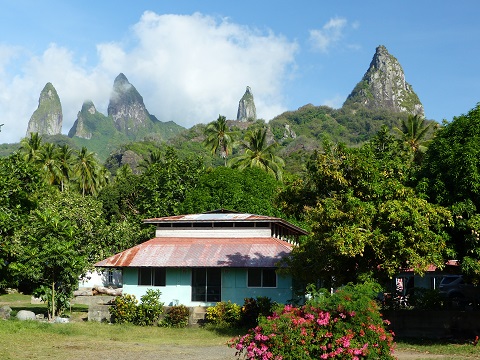 |
Random pictures from our month spent on the islands of Hiva Oa, Tahuata, Ua Pou, and Nuku Hiva
45 Photos
Created 18 July 2015
|
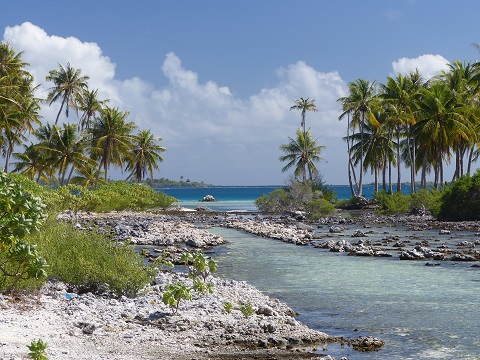 |
Random pictures from our month spent in 4 Tuamotu Atolls; Ahe, Fakarava, Tahanea, and Toau
32 Photos
Created 1 July 2015
|
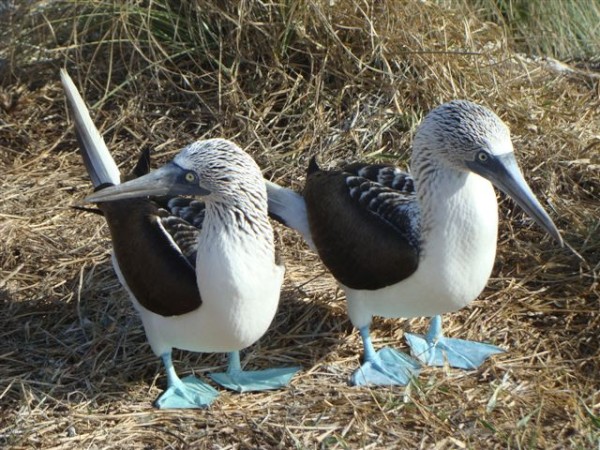 |
Some of the birds, fish, reptiles, and mammals (and others) that we have seen in Mexico
74 Photos
Created 5 May 2014
|
Tregoning

Who: Alison and Randall
Port: Gainesville, FL





